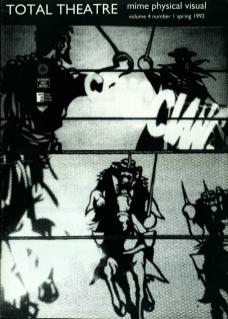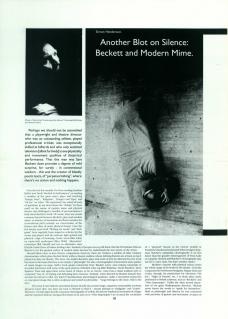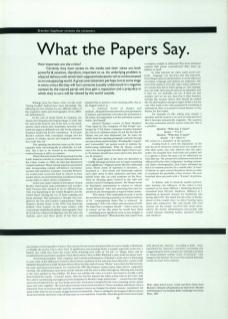Over the last few months I've been reading Jonathan Kalb's new book Beckett in Performance, re-reading a number of the great man's plays and watching Happy Days, Endgame, Krapp's Last Tape, and Eh Joe on video. The experience has raised all sorts of questions in my head about the ‘debate’ (is there one?) on the nature of modern mime and physical theatre and challenged a handful of preconceptions held about Beckett's work. Of course, there are certain common threads between Beckett's plays and modern mime: an absence of naturalism and linear narrative for conventional plot certainly are characteristic of the former and often of much physical theatre. Over the last twenty years both Waiting for Godot and Endgame have regularly been staged as vehicles for the clown and played with the internal – light spirited and physical – logic of clowning. Comic actors (Bert Lahr), ex music hall performers (Max Wall), ‘alternative’ comedians (Rik Mayall) and not so alternative ones (Charlie Drake) have all taken leading roles. Students of Jacques Lecoq will know that the Frenchman believes Beckett to be the greatest author of modem mime because he understands the true nature of the clown.
Beyond these more or less obvious comparisons, however, there are I believe a number of other common characteristics which place Beckett firmly within a theatre tradition whose defining features are at least as much physical as they are literary. The more one studies Beckett's plays and reads of how he directed his own work the clearer it becomes that here is not simply a ‘playwright’ but also a choreographer of movement and a painter of visual images on stage. Kalb's book quotes extensively from ‘Beckett actors’ and contains transcripts of recorded interviews with some of the great players of Beckett roles (e.g. Billy Whitelaw, David Warrilow, Alvin Epstein). Time and again these actors (none of whom, as far as I know, come from a mime tradition) refer to a physical ‘way in’ to finding and defending their character. Similarly, when directed by Beckett himself, they recount his refusal to offer any kind of Stanislavskian psychological guidance, rather a movement instruction or conceptual image that is often sculptural and rooted in physicality – ‘Gogo belongs to the stone, Didi to the tree.’
Of course if one believes movement theatre should also possess large, expansive and possibly acrobatic physical action then one does not look to Beckett to find it – except perhaps in Endgame and Godot. However, I would argue that the conscious choreography of a blink, the precise rhythmical movement of a finger and the repeated delicate and graceful sweep of an arm (as in Ohio Impromptu) are as much the vocabulary of a ‘physical theatre’ as the clown’s pratfall or Pantalone's backward somersault when enraged. Rosemary Butcher's minimalist choreography is no less dance than the grander extravagances of Swan Lake or Coppelia. Beckett and Butcher's choreography may not be to one's taste, but that's another matter.
Beckett's concern with physical action covers the whole range of his work for the theatre – from the comparatively well known Endgame, Happy Days and Godot, through his productions for television (Eh Joe, Night of Dreams etc...) to those plays rarely performed to British audience, such as Rockaby and Ohio Impromptu. Unlike the often heard injunction of our great Shakespearian directors, ‘Beckett never leaves the words to speak for themselves’. Both as playwright and director he was as concerned with precision of gesture and movement in space as any painter or choreographer of dance. But concern for movement and physicality was never simply to illuminate or amplify the poetry, but to add a level of significance and meaning which is equally important as the text. I turn down the sound when watching your video of Eh Joe or Happy Days and am transfixed by the movement qualities of Jack MacGowran's face or Billie Whitelaw's arms, head and upper body.
In his book, Jonathan Kalb compares and contrasts performances of Beckett's work and it is interesting to note some of the differences between MacGowran's portrayal of Joe and Jean-Louis Barrault's version (with Madeline Renauld) in 1968. Beckett did not direct the latter and of course Eh Joe was written for MacGowran, his close and much loved friend. I've watched the BBC/MacGowran version many times and it's compulsive viewing. The performance lasts about twenty minutes and the actor is silent throughout, listening to the voice spoken by Sian Phillips. We know not whether the voice is in Joe's own head or actually comes from behind the camera – it doesn't matter. After the first few minutes the entire action rests on Joe's face with the camera's positioning and angle precisely designated in Beckett's stage instructions: ‘...camera has nine slight moves in towards the face, say four inches each time. Each move is stopped by the voice resuming, never camera move and voice together.’ We watch MacGowran's every facial reaction to Voices words (an indictment of Joe's behaviour from an ex-lover/wife) and the movements convey we imagine his denial, remorse, resentment. The point is that what we see is rarely straight forward or immediate – there is ambiguity and enigma in MacGowran's facial movements and never a hint of histrionics or overstatement. Ironically, when the great French actor/mime artist played Joe, Barrault – according to Kalb – sentimentalised the character's reactions, overstating and exaggerating the facial acting in an ‘attempt to portray an inappropriately realistic sense of paranoia’. One imagines that Étienne Decroux (who trained Barrault) would not have been amused.
Apart from Lecoq's words and those drawn from Beckett's obituaries all quotations are taken from Beckett in Performance by Jonathan Kalb, Cambridge University Press, 1991.


